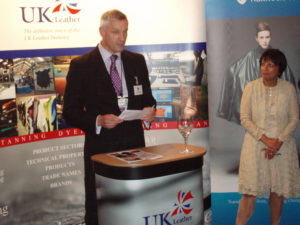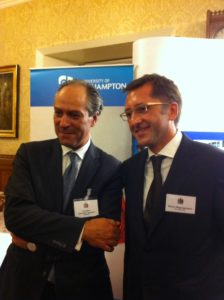POSTED ON.
UKLF has a new strategy

On Tuesday the 13thSeptember the UK Leather Federation launched a new strategy document in a combined meeting with the Institute for Creative Leather Technologies at the House of Lords in London. Reg Hankey of Pittards spoke on behalf of the UKLF and gave an excellent speech. Here it is in full:
“The purpose of this event is to launch our strategy for the UK leather industry – as a whole – manufacturers and support organisations. I speak as a manufacturer, and isn’t it refreshing to see that politicians, and others, are now talking about manufacturing as an activity that is important to the country.
“I am also talking about the leather industry – which on a global scale annually produces over 20 billion square feet of leather, worth over 40 billion us dollars. And it is part of a huge international trading chain – international trade in hides, skins, leather and leather footwear is worth 63 billion us dollars a year, which is far greater than many other important commodities. To put UK trade into context, in 2010, the UK exported hides skins and leather worth £307 million
“It is an opportunity also to remind everyone that while the UK leather industry may be quite small on a global scale, we can claim that technically, environmentally and socially it is just about the most advanced in the world. It was no accident that when the World Leather journal instituted the “tannery of the year” awards in 2010, based on technical/environmental/social and economic criteria – the Scottish Leather Group’s Bridge of Weir plant was named European tannery of the year and the Pittards’ Ethiopia Share Tannery company was named world tannery of the year.
“This recognition is due, not least, because of the unparalleled support infrastructure of education/training/technical/business support available to the industry in the UK from the university of Northampton, BLC, Leather Wise, Satra and others, and of course UK leather federation.
“This new strategy has been devised to build on this position and to take the industry forward. It outlines 6 main strategic areas to focus on.
1 research & development – the UK industry can’t compete in today’s world purely on price – we need to produce leather better, quicker, more cleanly, more consistently as well as cheaper, within the constraints that exist. We need to maintain and energise the collective scientific base that underpins all of these.
2 environment – this has always been a key issue for our industry – and because the challenge is so great, the tanning industry globally, and especially in the UK has tackled many of the issues in advance of other sectors and, indeed, the UK is ahead of other countries. On one hand this gives us a collective advantage, but we also have to keep up our efforts to meet the twin challenges of ever tighter controls at home, and less regulated competition from overseas – and at the same time there is a clear need to minimise the export of pollution – it is better to do it here!
3 brand – we need to maintain a strong national trade association linked with our European and international colleagues. Through this we will seek to protect and promote the leather industry and the image of leather – for example against misdescriptions and consumer confusion in the marketplace.
4 carbon footprint/sustainability – the way in which the leather industry is perceived by its customers is taking on a new dimension as regards carbon footprints and sustainability. While leather producers can exert influence over their own performance, there is an urgently growing need for the industry to work with its partners to establish sensible, authoritative methodologies to measure performance that are not grossly skewed by factors outside the control of the leather industry.
5 UK raw material – the UK has an abundance of raw material to supply the leather industry, in terms of cattle hides, sheep skins – and others such as deer skins – but the industry collectively does need to work on ways in which this supply can best be utilised for the benefit, not just of the leather industry, but the whole production chain. If the material is not processed in the UK and is exported raw, then it becomes just another world commodity, with minimal value added in this country.
6 education and people – it may sound like a cliché, but, truly, people are our most valuable asset and we are very fortunate in this country to have the facilities of not only the University of Northampton, with its comprehensive range of education courses on leather and leather related subjects, but also other technical training providers such as BLC, Satra and Leatherwise to support our industry’s need to have a well educated and well trained workforce.
“So, in brief, we have a small but competitive, specialised and technically advanced leather industry in the UK, with a very strong support base of internationally respected education, training and technical organisations. This is a situation that we need to recognise, to keep and to enhance.”

The audience covered all the UK leather industry and there was a good turnout. It was also pleasing that the School of Fashion and the Leather Conservation Centre were present, as was Nick Madeley from the Museum of Leathercraft. I think everyone was delighted that we also had some important visitors from the EU with Mr Mauro Magnaguagno of TFL Italia SpA and Mr Gustavo Gonzalez-Quijano of Cotance – who are featured in the attached photo.
Mike Redwood
14th September, 2011